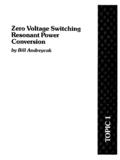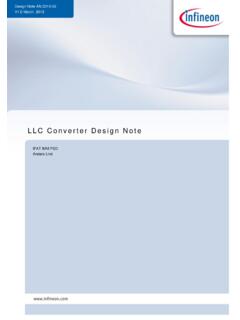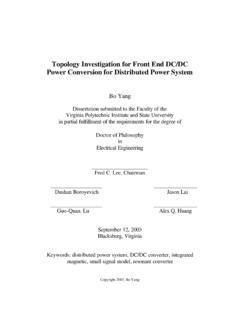Transcription of An introduction to LLC resonant half-bridge converter
1 September 2008 Rev 2 1/64AN2644 Application noteAn introduction to LLC resonanthalf- bridge converterIntroductionAlthough in existence for many years, only recently has the LLC resonant converter , in particular in its half - bridge implementation, gained in the popularity it certainly deserves. In many applications, such as flat panel TVs, 85+ ATX PCs or small form factor PCs, where the requirements on efficiency and power density of their SMPS are getting tougher and tougher, the LLC resonant half - bridge with its many benefits and very few drawbacks is an excellent solution. One of the major difficulties that engineers are facing with this topology is the lack of information concerning the way it operates.
2 The purpose of this application note is to provide insight into the topology and help familiarize the reader with it, therefore, the approach is essentially resonant topology schematics and Contents1 Classification of resonant converters .. 52 The LLC resonant half - bridge converter .. overview .. switching mechanism .. operating modes .. at resonance (f = fR1) .. 21 Remarks .. above resonance (f > fR1) .. 24 CCMA operation at heavy load.. 25 Remarks .. 26 DCMA at medium load .. 28 Remarks .. 28 DCMAB at light load .. 29 Remarks .. below resonance (fR2 < f < fR1, R>Rcrit).
3 30 DCMAB at medium-light load .. 30 DCMB at heavy load.. 30 Remarks .. operation below resonance (fR2 < f < fR1, R<Rcrit) .. 34 Remarks .. operation .. and short circuit operation .. 's startup .. of power losses .. behavior .. above resonance (f > fR1) .. below resonance (fR2 < f < fR1, R>Rcrit) .. at resonance (f = fR1) .. 443 Conclusion .. 464 References .. 47 Appendix A Power MOSFET driving energy in ZVS operation .. 48AN2644 Contents3/64 Appendix B resonant transitions of half - bridge midpoint .. 50 Appendix C Power MOSFET effective Coss and half - bridge midpoint's transition times.
4 54 Appendix D Power MOSFETs switching losses at turn-off.. 59 Appendix E Input current in LLC resonant half - bridge with split resonant capacitors .. 61 Revision history .. 63 List of figuresAN26444/64 List of figuresFigure resonant topology schematics and waveforms .. 1 Figure block diagram of a resonant inverter, the core of resonant converters .. 5 Figure resonant half - bridge schematic .. 6 Figure resonant half - bridge with split resonant capacitor .. 8 Figure schematic of a real transformer (left, tapped secondary; right, single secondary) .. 9 Figure of high-leakage magnetic structures (cross-section).
5 9 Figure schematic of a transformer including parasitic capacitance .. 12 Figure MOSFET totem-pole network driving a resonant tank circuit in a half - bridge converter .. 13 Figure of Q1 ON-OFF and Q2 OFF-ON transitions with soft-switching for Q2 .. 14 Figure gate voltage at turn-on: with soft-switching .. 14 Figure gate voltage at turn-on: with hard-switching (no ZVS) .. 14 Figure ON-OFF and Q2 OFF-ON transitions with hard switching for Q2 and recovery for DQ1 .. 16 Figure leg transitions in the neighborhood of inductive-capacitive regions boundary .. 17 Figure leg transitions under no-load conditions.
6 19 Figure LLC converter for the analysis of the fundamental operating modes .. 21 Figure at resonance (f = fR1): main waveforms .. 22 Figure above resonance (f > fR1): main waveforms in CCMA operation at heavy load 25 Figure above resonance (f > fR1): main waveforms in DCMA operation at medium load .. 27 Figure above resonance (f > fR1): main waveforms in DCMAB operation at light load .. 30 Figure below resonance (fR2 < f < fR1 , R>Rcrit): main waveforms in DCMAB operation .. 31 Figure below resonance (fR2 < f < fR1, R>Rcrit): main waveforms in DCMB2 operation 32 Figure mode operation below resonance (fR2 < f < fR1, R<Rcrit): main waveforms.
7 35 Figure operation (cutoff): main waveforms .. 36 Figure 's equivalent schematic under: no-load conditions .. 38 Figure 's equivalent schematic under: short-circuit conditions.. 38 Figure 's startup: main waveforms .. 40 Figure driving with bootstrap approach and bootstrap capacitor charge path .. 41 Figure compensation with an isolated type 3 amplifier (3 poles + 2 zeros) .. 45 Figure of gate-charge characteristics with and without ZVS .. 48 Figure circuit to analyze the transitions of the half - bridge midpoint node when Q2 turns off .. 50 Figure of HB node vs time (see Equation 32).
8 53 Figure current vs time (see Equation 34) .. 53 Figure associated to the half - bridge midpoint node .. 54 Figure capacitances vs. half - bridge midpoint's voltage .. 55 Figure schematic to analyze transition times of the node HB when Q2 turns off .. 56 Figure of Q2 turn-off transient .. 57 Figure current components in a split-capacitor LLC resonant half - bridge .. 61 Figure diagram showing currents flow in the converter of Figure 37 .. 61AN2644 Classification of resonant converters5/641 Classification of resonant convertersResonant conversion is a topic that is at least thirty years old and where much effort has been spent in research in universities and industry because of its attractive features: smooth waveforms, high efficiency and high power density.
9 Yet the use of this technique in off-line powered equipment has been confined for a long time to niche applications: high-voltage power supplies or audio systems, to name a few. Quite recently, emerging applications such as flat panel TVs on one hand, and the introduction of new regulations, both voluntary and mandatory, concerning an efficient use of energy on the other hand, are pushing power designers to find more and more efficient AC-DC conversion systems. This has revamped and broadened the interest in resonant conversion . Generally speaking, resonant converters are switching converters that include a tank circuit actively participating in determining input-to-output power flow.
10 The family of resonant converters is extremely vast and it is not an easy task to provide a comprehensive picture. To help find one's way, it is possible to refer to a property shared by most, if not all, of the members of the family. They are based on a " resonant inverter", a system that converts a DC voltage into a sinusoidal voltage (more generally, into a low harmonic content ac voltage), and provides ac power to a load. To do so, a switch network typically produces a square-wave voltage that is applied to a resonant tank tuned to the fundamental component of the square wave. In this way, the tank will respond primarily to this component and negligibly to the higher order harmonics, so that its voltage and/or current, as well as those of the load, will be essentially sinusoidal or piecewise sinusoidal.












